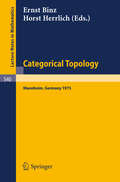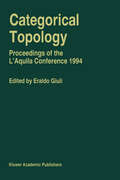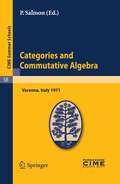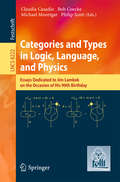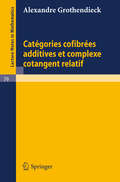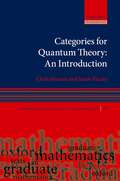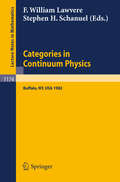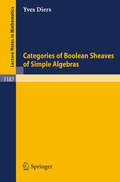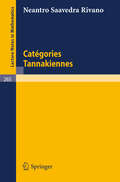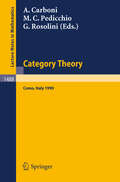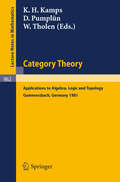- Table View
- List View
Categorical Donaldson-Thomas Theory for Local Surfaces (Lecture Notes in Mathematics #2350)
by Yukinobu TodaThis book provides an introduction to categorical Donaldson-Thomas (DT) theory, a rapidly developing field which has close links to enumerative geometry, birational geometry, geometric representation theory and classical moduli problems in algebraic geometry. The focus is on local surfaces, i.e. the total spaces of canonical line bundles on algebraic surfaces, which form an interesting class of Calabi-Yau 3-folds. Using Koszul duality equivalences and singular support theory, dg-categories are constructed which categorify Donaldson-Thomas invariants on local surfaces. The DT invariants virtually count stable coherent sheaves on Calabi-Yau 3-folds, and play an important role in modern enumerative geometry, representation theory and mathematical physics. Requiring a basic knowledge of algebraic geometry and homological algebra, this monograph is primarily addressed to researchers working in enumerative geometry, especially Donaldson-Thomas theory, derived categories of coherent sheaves, and related areas.
Categorical Perspectives (Trends in Mathematics)
by Jürgen Koslowski Austin Melton"Categorical Perspectives" consists of introductory surveys as well as articles containing original research and complete proofs devoted mainly to the theoretical and foundational developments of category theory and its applications to other fields. A number of articles in the areas of topology, algebra and computer science reflect the varied interests of George Strecker to whom this work is dedicated. Notable also are an exposition of the contributions and importance of George Strecker's research and a survey chapter on general category theory. This work is an excellent reference text for researchers and graduate students in category theory and related areas. Contributors: H.L. Bentley * G. Castellini * R. El Bashir * H. Herrlich * M. Husek * L. Janos * J. Koslowski * V.A. Lemin * A. Melton * G. Preuá * Y.T. Rhineghost * B.S.W. Schroeder * L. Schr"der * G.E. Strecker * A. Zmrzlina
Categorical Structure of Closure Operators: With Applications to Topology, Algebra and Discrete Mathematics (Mathematics and Its Applications #346)
by D. Dikranjan Walter TholenOur motivation for gathering the material for this book over aperiod of seven years has been to unify and simplify ideas wh ich appeared in a sizable number of re search articles during the past two decades. More specifically, it has been our aim to provide the categorical foundations for extensive work that was published on the epimorphism- and cowellpoweredness problem, predominantly for categories of topological spaces. In doing so we found the categorical not ion of closure operators interesting enough to be studied for its own sake, as it unifies and describes other significant mathematical notions and since it leads to a never-ending stream of ex amples and applications in all areas of mathematics. These are somewhat arbitrarily restricted to topology, algebra and (a small part of) discrete mathematics in this book, although other areas, such as functional analysis, would provide an equally rich and interesting supply of examples. We also had to restrict the themes in our theoretical exposition. In spite of the fact that closure operators generalize the uni versal closure operations of abelian category theory and of topos- and sheaf theory, we chose to mention these aspects only en passant, in favour of the presentation of new results more closely related to our original intentions. We also needed to refrain from studying topological concepts, such as compactness, in the setting of an arbitrary closure-equipped category, although this topic appears prominently in the published literature involving closure operators.
Categorical Topology: Proceedings of the Conference held at Mannheim, 21-25 July 1975 (Lecture Notes in Mathematics #540)
by E. Binz H. HerrlichCategorical Topology: Proceedings of the L’Aquila Conference (1994)
by Eraldo GiuliProceedings of the L'Aquila Conference 1994
Categorical Topology: Proceedings of the International Conference, Berlin, August 27th to September 2nd 1978 (Lecture Notes in Mathematics #719)
by H. Herrlich G. PreußCategorical Variables in Developmental Research: Methods of Analysis
by Alexander Von Eye Clifford C. CloggCategorical Variables in Developmental Research provides developmental researchers with the basic tools for understanding how to utilize categorical variables in their data analysis. Covering the measurement of individual differences in growth rates, the measurement of stage transitions, latent class and log-linear models, chi-square, and more, the book provides a means for developmental researchers to make use of categorical data.Measurement and repeated observations of categorical data Catastrophe theoryLatent class and log-linear modelsApplications
Categories
by Horst SchubertCategorical methods of speaking and thinking are becoming more and more widespread in mathematics because they achieve a unifi cation of parts of different mathematical fields; frequently they bring simplifications and provide the impetus for new developments. The purpose of this book is to introduce the reader to the central part of category theory and to make the literature accessible to the reader who wishes to go farther. In preparing the English version, I have used the opportunity to revise and enlarge the text of the original German edition. Only the most elementary concepts from set theory and algebra are assumed as prerequisites. However, the reader is expected to be mathe to follow an abstract axiomatic approach. matically sophisticated enough The vastness of the material requires that the presentation be concise, and careful cooperation and some patience is necessary on the part of the reader. Definitions alway precede the examples that illuminate them, and it is assumed that the reader is familiar with some of the algebraic and topological examples (he should not let the other ones confuse him). It is also hoped that he will be able to explain the con cepts to himself and that he will recognize the motivation.
Categories and Commutative Algebra: Lectures given at a Summer School of the Centro Internazionale Matematico Estivo (C.I.M.E.) held in Varenna (Como), Italy, September 12-21,1971 (C.I.M.E. Summer Schools #58)
by P. SalmonL. Badescu: Sur certaines singularités des variétés algébriques.- D.A. Buchsbaum: Homological and commutative algebra.- S. Greco: Anelli Henseliani.- C. Lair: Morphismes et structures algébriques.- B.A. Mitchell: Introduction to category theory and homological algebra.- R. Rivet: Anneaux de séries formelles et anneaux henseliens.- P. Salmon: Applicazioni della K-teoria all’algebra commutativa.- M. Tierney: Axiomatic sheaf theory: some constructions and applications.- C.B. Winters: An elementary lecture on algebraic spaces.
Categories and Sheaves (Grundlehren der mathematischen Wissenschaften #332)
by Masaki Kashiwara Pierre SchapiraCategories and sheaves appear almost frequently in contemporary advanced mathematics. This book covers categories, homological algebra and sheaves in a systematic manner starting from scratch and continuing with full proofs to the most recent results in the literature, and sometimes beyond. The authors present the general theory of categories and functors, emphasizing inductive and projective limits, tensor categories, representable functors, ind-objects and localization.
Categories and Types in Logic, Language, and Physics: Essays dedicated to Jim Lambek on the Occasion of this 90th Birthday (Lecture Notes in Computer Science #8222)
by Claudia Casadio Bob Coecke Michael Moortgat Philip ScottFor more than 60 years, Jim Lambek has been a profoundly inspirational mathematician, with groundbreaking contributions to algebra, category theory, linguistics, theoretical physics, logic and proof theory. This Festschrift was put together on the occasion of his 90th birthday. The papers in it give a good picture of the multiple research areas where the impact of Jim Lambek's work can be felt. The volume includes contributions by prominent researchers and by their students, showing how Jim Lambek's ideas keep inspiring upcoming generations of scholars.
Categories, Bundles and Spacetime Topology (Mathematics and Its Applications #45)
by C.T. DodsonApproach your problems from the right end It isn't that they can't see the solution. It is and begin with the answers. Then one day, that they can't see the problem. perhaps you will find the final question. G. K. Chesterton. The Scandal of Father 'The Hermit Gad in Crane Feathers' in R. Brown'The point of a Pin'. van Gulik's TheChinese Maze Murders. Growing specialization and diversification have brought a host of monographs and textbooks on increasingly specialized topics. However, the "tree" of knowledge of mathematics and related fields does not grow only by putting forth new branches. It also happens, quite often in fact, that branches which were thought to be completely disparate are suddenly seen to be related. Further, the kind and level of sophistication of mathematics applied in various sciences has changed drastically in recent years: measure theory is used (non-trivially) in regional and theoretical economics; algebraic geometry interacts with physics; the Minkowsky lemma, coding theory and the structure of water meet one another in packing and covering theory; quantum fields, crystal defects and mathematical programming profit from homotopy theory; Lie algebras are relevant to filtering; and prediction and electrical engineering can use Stein spaces. And in addition to this there are such new emerging SUbdisciplines as "experimental mathematics", "CFD", "completely integrable systems", "chaos, synergetics and large-scale order", which are almost impossible to fit into the existing classification schemes. They draw upon widely different sections of mathematics.
Categories Confibrees Additives et Complexe Cotangent Relatif (Lecture Notes in Mathematics #79)
by Alexandre GrothendieckCategories for Quantum Theory: An Introduction (Oxford Graduate Texts in Mathematics)
by Chris Heunen Jamie VicaryMonoidal category theory serves as a powerful framework for describing logical aspects of quantum theory, giving an abstract language for parallel and sequential composition, and a conceptual way to understand many high-level quantum phenomena. This text lays the foundation for this categorical quantum mechanics, with an emphasis on the graphical calculus which makes computation intuitive. Biproducts and dual objects are introduced and used to model superposition and entanglement, with quantum teleportation studied abstractly using these structures. Monoids, Frobenius structures and Hopf algebras are described, and it is shown how they can be used to model classical information and complementary observables. The CP construction, a categorical tool to describe probabilistic quantum systems, is also investigated. The last chapter introduces higher categories, surface diagrams and 2-Hilbert spaces, and shows how the language of duality in monoidal 2-categories can be used to reason about quantum protocols, including quantum teleportation and dense coding. Prior knowledge of linear algebra, quantum information or category theory would give an ideal background for studying this text, but it is not assumed, with essential background material given in a self-contained introductory chapter. Throughout the text links with many other areas are highlighted, such as representation theory, topology, quantum algebra, knot theory, and probability theory, and nonstandard models are presented, such as sets and relations. All results are stated rigorously, and full proofs are given as far as possible, making this book an invaluable reference for modern techniques in quantum logic, with much of the material not available in any other textbook.
Categories for the Working Mathematician (Graduate Texts in Mathematics #5)
by Saunders Mac LaneAn array of general ideas useful in a wide variety of fields. Starting from the foundations, this book illuminates the concepts of category, functor, natural transformation, and duality. It then turns to adjoint functors, which provide a description of universal constructions, an analysis of the representations of functors by sets of morphisms, and a means of manipulating direct and inverse limits. These categorical concepts are extensively illustrated in the remaining chapters, which include many applications of the basic existence theorem for adjoint functors. The categories of algebraic systems are constructed from certain adjoint-like data and characterised by Beck's theorem. After considering a variety of applications, the book continues with the construction and exploitation of Kan extensions. This second edition includes a number of revisions and additions, including new chapters on topics of active interest: symmetric monoidal categories and braided monoidal categories, and the coherence theorems for them, as well as 2-categories and the higher dimensional categories which have recently come into prominence.
Categories for the Working Mathematician (Graduate Texts in Mathematics #5)
by Saunders MacLaneCategory Theory has developed rapidly. This book aims to present those ideas and methods which can now be effectively used by Mathe maticians working in a variety of other fields of Mathematical research. This occurs at several levels. On the first level, categories provide a convenient conceptual language, based on the notions of category, functor, natural transformation, contravariance, and functor category. These notions are presented, with appropriate examples, in Chapters I and II. Next comes the fundamental idea of an adjoint pair of functors. This appears in many substantially equivalent forms: That of universal construction, that of direct and inverse limit, and that of pairs offunctors with a natural isomorphism between corresponding sets of arrows. All these forms, with their interrelations, are examined in Chapters III to V. The slogan is "Adjoint functors arise everywhere". Alternatively, the fundamental notion of category theory is that of a monoid -a set with a binary operation of multiplication which is associative and which has a unit; a category itself can be regarded as a sort of general ized monoid. Chapters VI and VII explore this notion and its generaliza tions. Its close connection to pairs of adjoint functors illuminates the ideas of universal algebra and culminates in Beck's theorem characterizing categories of algebras; on the other hand, categories with a monoidal structure (given by a tensor product) lead inter alia to the study of more convenient categories of topological spaces.
Categories in Continuum Physics: Lectures Given at a Workshop Held at SUNY, Buffalo 1982 (Lecture Notes in Mathematics #1174)
by F. William Lawvere Stephen H. SchanuelCategories of Algebraic Systems: Vector and Projective Spaces, Semigroups, Rings and Lattices (Lecture Notes in Mathematics #553)
by M. PetrichCategory Seminar: Proceedings Sydney Category Theory Seminar 1972 /1973 (Lecture Notes in Mathematics #420)
by G. M. KellyCategory Theory: Proceedings of the International Conference held in Como, Italy, July 22-28, 1990 (Lecture Notes in Mathematics #1488)
by Aurelio Carboni Maria C. Pedicchio Giuseppe RosoliniWith one exception, these papers are original and fully refereed research articles on various applications of Category Theory to Algebraic Topology, Logic and Computer Science. The exception is an outstanding and lengthy survey paper by Joyal/Street (80 pp) on a growing subject: it gives an account of classical Tannaka duality in such a way as to be accessible to the general mathematical reader, and to provide a key for entry to more recent developments and quantum groups. No expertise in either representation theory or category theory is assumed. Topics such as the Fourier cotransform, Tannaka duality for homogeneous spaces, braided tensor categories, Yang-Baxter operators, Knot invariants and quantum groups are introduced and studies. From the Contents: P.J. Freyd: Algebraically complete categories.- J.M.E. Hyland: First steps in synthetic domain theory.- G. Janelidze, W. Tholen: How algebraic is the change-of-base functor?.- A. Joyal, R. Street: An introduction to Tannaka duality and quantum groups.- A. Joyal, M. Tierney: Strong stacks andclassifying spaces.- A. Kock: Algebras for the partial map classifier monad.- F.W. Lawvere: Intrinsic co-Heyting boundaries and the Leibniz rule in certain toposes.- S.H. Schanuel: Negative sets have Euler characteristic and dimension.-



